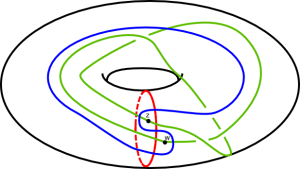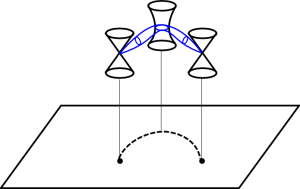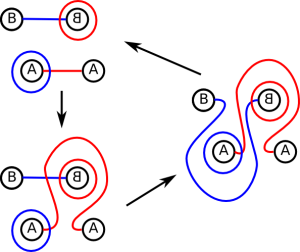I’m excited to be joining the blog. I’ve been consumed mainly by watching talks and meeting people at the Stanford conference, so this first post will consist only of my notes from Andras Stipsicz‘s talk on lattice homology. The content of the talk represents joint work of Stipsicz with Ozsváth and Szabó. I don’t have a lot of experience with lattice homology, so if I’ve missed or misunderstood something, please contribute your corrections in the comments section.
The talk began with a review of the standard Heegaard Floer package. Knot Floer homology was recently mentioned on the blog when Laura discussed Zoltan Szabó’s research talk at Budapest. So, if you’d like a refresher on notation, please check out that post (but feel free to skip the bordered part if you’re in a rush).
With an powerful invariant like Heegaard Floer (or knot Heggaard Floer), a lot of people are interested in how to compute it. Stipsicz gave an overview of some of the pertinent questions about computation and existing technology.
Computational aspects:
- How to compute the invariant in a simple way?
- How to prove invariance in a simple way? (Simple here means without infinite dimensional analysis or having to count pseduoholomorphic curves.)
- Can you find an effective way of computing invariants? (Effective depends on your personal opinion of an efficient algorithm.)
Existing technology:
- Sarkar-Wang (2006) – “Nice” diagrams allow you to compute HF-hat.
- Manolescu-Ozsváth-Sarkar and Manolescu-Ozsváth-Szabó -Thurston – Grid diagrams allow for a combinatorial descriptions of the knot and link invariants.
- Ozsváth-Sarkar-Szabó (2007) – Verification of independence with special nice diagrams for HF.
- New algorithms coming from Lipshitz-Ozsváth-Thurston’s bordered Floer homology.
The first two references mentioned are examples of simple ways to compute the invariants. The cost of theoretical simplicity, though, is a miserably inefficient algorithm. For example, the algorithm that computes HFK from a grid diagram has order of complexity somewhere in the neighborhood of . Yikes! The bordered techniques are computationally better, but require some rather difficult algebra.
So keeping these motivating issues in mind, let’s see what Stipsicz said about lattice homology and how it relates to Heegaard Floer.
Lattice homology
Suppose that is a tree with integer weights
associated to its vertices
. We consider the plumbing construction
. This means that
is the compact oriented 4-manifold obtained by plumbing
bundles over
with Euler numbers given by the weights
and plumbing instructions indicated by the graph. The three dimensional boundary
of the resulting manifold is our object of interest.
The construction that follows is due to Nèmethi in 2008:
Define to be
mod 2 for all
, i.e. the set of characteristic elements in the second integral cohomology group of
.
Let denote the
module freely generated over
by pairs
, where
is a characteristic covector and
is a subset of vertices in
.
The differential of this complex is given by:
Those exponents and
are integers which are defined with an auxiliary function
. If
, then
. That second term represents a self-intersection in
. Let:
Also note that since specifies a spin-c structure on
, we associate to
the spin-c structure
.
OK. That sets up the lattice homology, more or less. I don’t really understand what the differential is actually doing, but its apparent benefit is that it is defined in a combinatorial manner (i.e. no counts of holomorphic curves). If anyone would like to really understand this, it would probably be best to check out the papers by Nèmethi and Ozsváth, Stipsicz, and Szabó.
Rational graphs
My notes became somewhat illegible at this point in the lecture, so I’ve attempted to vet this section with some information from this paper. Let’s assume that is a negative definite plumbing graph. We’d like to get a handle on when
is rational, and as it turns out, there is a combinatorial algorithm that does this.
Algorithm. Let
, and compute all of the products
. If:
- any of the products is greater than or equal to 2, stop.
is not rational.
- all of the products are less than or equal to 0, stop.
is rational.
- any product
, then set
and repeat.
(I’m being a bit sloppy here with the notation; stands for both a vertex and the second homology class in the plumbed manifold corresponding to that vertex.) This algorithm produces a series of vectors
, and terminates in finite time. The product, by the way, is a dot product computed in the intersection matrix of the four-manifold. I believe
was a suggested example of a rational graph on which to perform the algorithm.
Additionally, we say that is of type-k if there exists vertices
such that sufficiently decreasing the weights
makes
rational.
So why do we care about types of rational graphs? The following theorem of Nèmethi in 2008:
Theorem. Suppose is negative definite plumbing tree. Then,
is a three-manifold invariant.
is rational if and only if
for all spin-c structures over
.
- If
is of type-1 this implies
.
Moreover, there exists a surgery exact sequence for lattice homology, a result also obtained independently by Josh Greene. The theorem leads to the conjecture that for any plumbing tree
. To this end, there is a theorem of Ozsváth, Stipsicz, and Szabó that tells us there is a spectral sequence on
converging to
. If
is of type-2, the spectral sequence collapses and the homology groups are isomorphic.
Refinement to knots
Are you still hanging in there? Great! Onward to knots.
Now, we let denote a plumbing graph with a distinguished, unweighted vertex
. Define the lattice chain complex on
. The vertex
induces a filtration
on the lattice homology complex. For a generator
of the lattice complex, the filtration level
is given by a formula that is essentially the same as the auxiliary function
above, except it use a specific extension of
and
to
. The filtered complex
is the subject of the main theorem:
Theorem. Suppose the tree with distinguished vertex
is given, that
negative definite, and that
is negative definite* for
. Then
determines the lattice chain complex
(*I took to mean that we’ve put a framing of
on the vertex
, large enough to ensure that
is an L-space.)
You might be asking yourself where does the knot fit into this picture? Well, when you do the plumbing, the unknot living at the distinguished vertex becomes knotted. That’s the knot. It’s also important to note that while knot Floer homology is defined for all knots, the construction described above is not. It works for connected sums of iterated torus knots, but certainly not all knots.
I do not have very detailed notes about the proof of the theorem, but it seemed to me to be a consequence of a complicated and formal similarity of homological algebra. In Heegaard Floer, is a doubly filtered complex. The filtrations can be used to chop up the complex into various subcomplexes, and then these these subcomplexes, the maps relating them, and their mapping cones are used to describe the Heegard Floer of surgeries along
. Here is a paper that details this construction.
Apparently, lattice homology also enjoys such a structure. The ‘infinity’ lattice complex is doubly filtered by the action of
and an extension of
. It, too, can be chopped up into subcomplexes, the mapping cones of which are quasi-isomorphic to lattice complexes of
.
Relating the Heegaard Floer and lattice complexes takes more work. Unfortunately, there isn’t much I am able to say about this. So, let me just say that lattice homology is really interesting and I’m looking forward to learning more about it.
I’ll sign-off by reporting the big result in Ozsváth, Stipsicz, and Szabó‘s paper.
Theorem. If is a plumbing graph with a distinguished vertex
such that the components of
are all rational, then the filtered chain complex of
in lattice homology is filtered chain homotopy equivalent to the filtered complex for
in Heegaard Floer.
…and it’s wonderful corollary:
Corollary. The lattice homology of a knot in is equal to its knot Floer homology.









